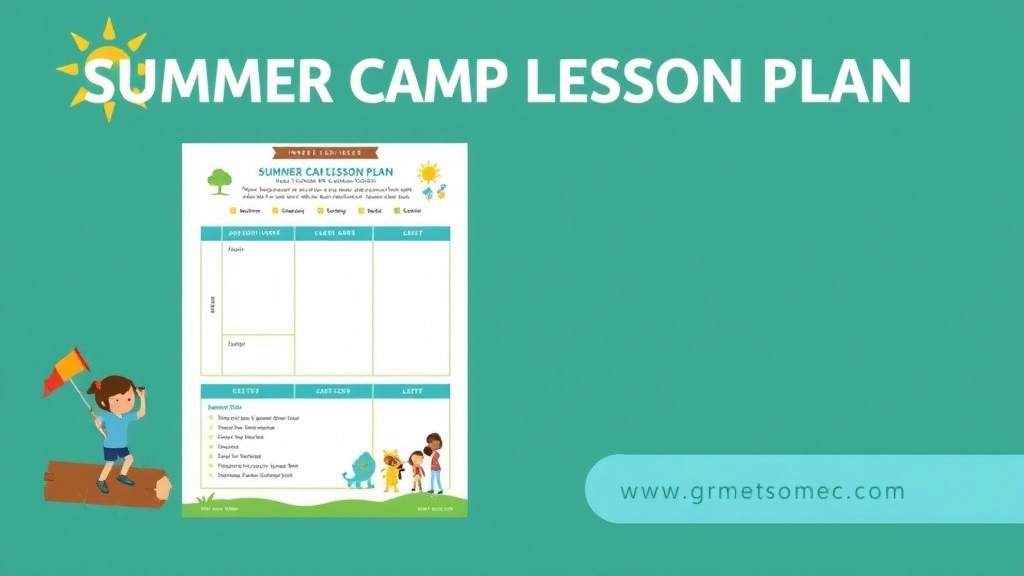Looking for the perfect Summer Camp Lesson Plan Template?
You’ve come to the right place! As someone who’s been in your shoes, I know how crucial it is to have a well-structured yet flexible plan to keep the kids engaged and learning. Whether you’re an educator, camp organizer, or a parent, this guide will help you create an unforgettable summer camp experience.
Our Templates
Our templates are designed to cater to various age groups and interests, from STEM and creative arts to outdoor adventures. With these easy-to-use resources, you’ll be able to plan activities that are both fun and educational, ensuring a balanced and enriching camp environment.
Let’s Dive In
and make your summer camp planning a breeze!
Key Components of a Summer Camp Lesson Plan
Alright, let’s dive into the nitty-gritty of what makes a summer camp lesson plan rock-solid. You know, the kind that keeps kids buzzing with excitement and learning without even realising it. We’re talking about the backbone of your camp, the stuff that makes it all come together seamlessly.
Why is a Lesson Plan Crucial?
First off, why bother with a lesson plan? Imagine trying to build a house without a blueprint. Chaos, right? A lesson plan is your blueprint. It keeps you organised, ensures you hit all the learning goals, and helps you manage your time effectively. Plus, it keeps the kids engaged and ensures they’re getting the most out of their camp experience.
Key Components to Include
So, what exactly should be in this golden document? Here’s the lowdown:
- Objectives: What do you want the kids to learn or achieve by the end of the session? Be clear and specific.
- Materials Needed: List everything you need, from art supplies to science kits. Trust me, you don’t want to realise you’re missing a crucial item mid-activity.
- Detailed Activity Plan: Break down the activity step-by-step. Include instructions, timings, and any variations for different age groups.
- Assessment Methods: How will you know if the kids have met the objectives? This could be through a simple Q&A, a mini-project, or even a group discussion.
- Backup Plan: Always have a Plan B. Weather can change, materials can go missing, and attention spans can wane. Be ready to pivot.
Example: Crafting a Science Experiment Lesson Plan
Let’s say you’re planning a science experiment. Here’s how you might structure it:
- Objective: Understand the basics of chemical reactions.
- Materials Needed: Baking soda, vinegar, food colouring, plastic bottles.
- Activity Plan:
- Introduction (5 mins): Explain the concept of chemical reactions.
- Demonstration (10 mins): Show a simple baking soda and vinegar reaction.
- Hands-On Activity (20 mins): Kids perform the experiment in small groups.
- Discussion (10 mins): Talk about what happened and why.
- Assessment Methods: Ask questions about the experiment and have kids explain the reaction in their own words.
- Backup Plan: If materials run out, switch to a discussion on everyday chemical reactions (like baking a cake).
Pro Tips for Success
- Keep it Dynamic: Mix up activities to cater to different learning stylesâvisual, auditory, and kinesthetic.
- Engage with Stories: Kids love stories. Relate the lesson to a fun anecdote or a real-world example.
- Be Flexible: Sometimes things won’t go as planned. That’s okay. Adapt and keep the energy positive.
For more ideas on activities, check out our summer camp play games, crafts, and activities guide. And if you’re looking for ways to keep your campers cool and comfortable, don’t miss our best tips to keep your camper cool in summer.
Creating Engaging Themed Activities
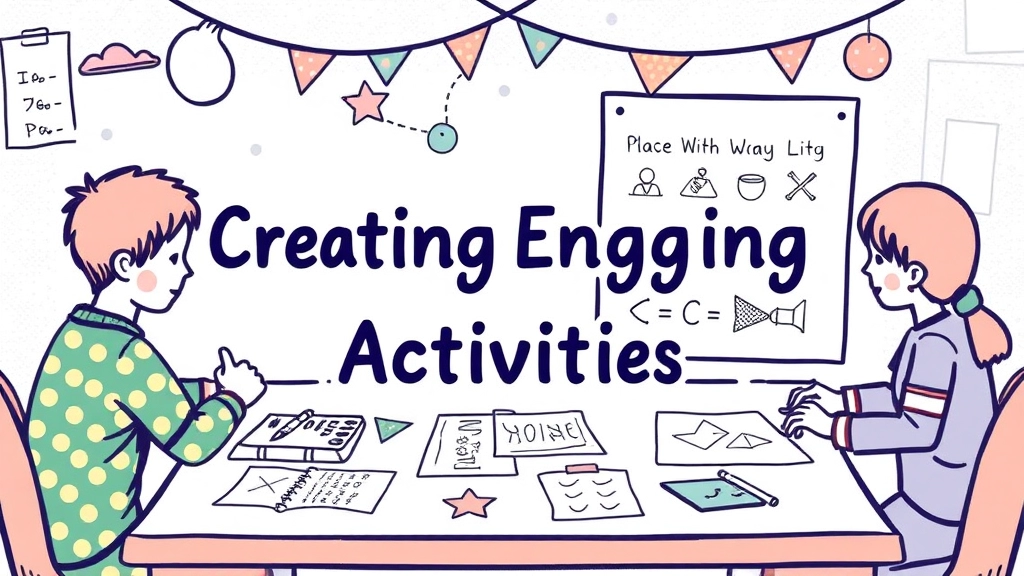
Ever wonder how to make summer camp activities so engaging that kids can’t wait to come back each day?
Well, you’re in the right place.
Let’s dive into creating themed activities that turn ordinary days into unforgettable adventures.
Why Themed Activities?
Themes give structure and excitement to your camp.
They make planning easier and keep kids engaged.
Imagine a pirate day where kids hunt for treasure or a science day filled with DIY experiments.
Steps to Create Themed Activities
-
Pick a Theme: Choose something broad enough to have multiple activities but specific enough to be exciting.
- Popular Themes: Space exploration, jungle safari, medieval times, superheroes, underwater adventure.
-
Plan Activities Around the Theme:
- Variety is Key: Mix physical activities, crafts, and educational bits.
- Example: For a Space Theme, you could have:
- Rocket-building crafts
- Space trivia games
- Stories about astronauts
-
Gather Supplies:
- Make a list of everything you’ll need.
- Keep it simple and cost-effective.
-
Create a Schedule:
- Map out the day with different activities.
- Include breaks and free time.
Tips for Keeping It Fresh
- Rotate Themes: Change themes weekly or bi-weekly to keep things exciting.
- Involve the Kids: Let them vote on themes or suggest activities.
- Stay Flexible: Be ready to adapt if something isn’t working.
Real Examples
Last summer, we did a “Superhero Week.”
Kids created their own superhero masks, participated in obstacle courses, and even wrote short stories about their characters.
It was a hit.
Another favourite was “Under the Sea.”
We had water games, made jellyfish crafts, and even had a mini science lesson about ocean life.
Tips for Balancing Fun and Learning
Alright, let’s cut to the chase. Balancing fun and learning at a summer camp is like walking a tightrope. You don’t want to tip too far into boring lessons, but you also can’t let it turn into a free-for-all. So, how do you strike that perfect balance?
Real Concerns Camp Leaders Face
- How can I keep kids engaged without them realising they’re learning?
- What if the activities are too fun and they forget the educational part?
- How do I manage different learning styles and energy levels?
Keep It Real, Keep It Fresh
First things first, fun and learning aren’t mutually exclusive. Here’s how you can blend them seamlessly:
- Gamify the Learning: Turn educational content into games. Kids love competition, and it keeps them hooked.
- Interactive Sessions: Use hands-on activities instead of lectures. Think science experiments, art projects, and role-playing.
- Themed Days: Have themed days that mix learning with fun. One day could be “Space Exploration” where they learn about planets and make rocket models.
Break It Down
Let’s chop up some complex tips into bite-sized pieces:
- Short and Sweet: Keep educational segments short. Attention spans are like goldfishâabout 7-10 minutes.
- Frequent Breaks: Alternate between learning and play. A 15-minute learning session followed by a 15-minute game works wonders.
- Incorporate Movement: Use activities that require physical movement. It helps in better retention of information.
Real-Life Examples
Imagine this: You’re running a camp with a focus on nature and wildlife. Instead of just talking about different types of trees, you could:
- Scavenger Hunt: Create a scavenger hunt where kids identify various plants and animals.
- Nature Journals: Have them keep a nature journal where they draw and write about their findings.
- Story Time: Share stories about famous naturalists. Make it interactive by letting them act out parts.
Stories Over Coffee
I remember a summer camp where we had a “Mad Scientist Day.” We combined chemistry lessons with fun experiments like making slime and volcano eruptions. The kids were so engrossed in the activities that they didn’t even realise they were learning complex scientific concepts. It was a win-win!
For more ideas on how to make your camp both fun and educational, check out our top summer camp tips and reviews from Reddit and explore our memorable summer camp speech tips and tricks.
Incorporating STEM and Creative Arts
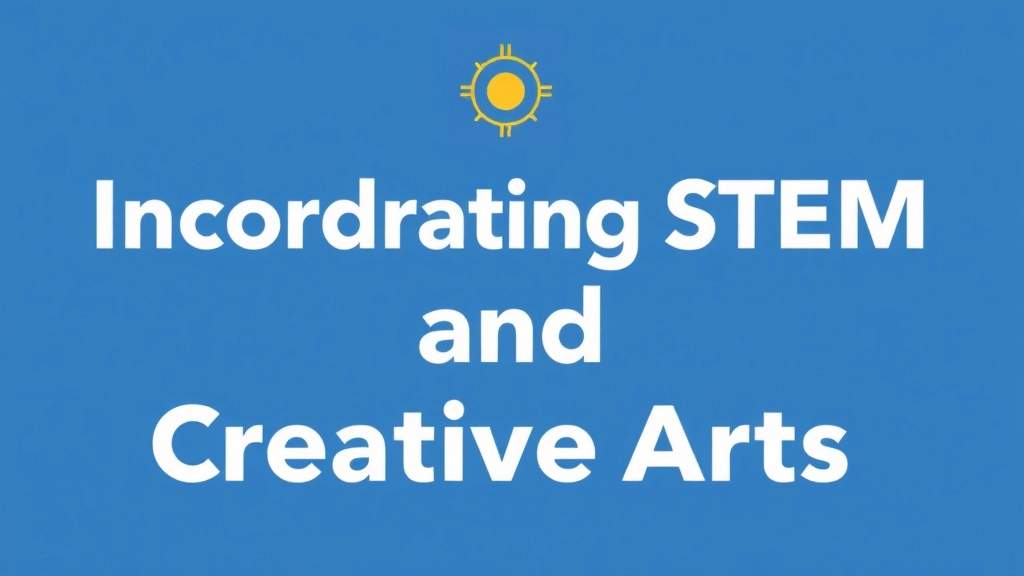
Struggling to keep kids engaged while sneaking in some learning?
We’ve all been there. Keeping the balance between fun and education at a summer camp can be a tightrope walk. But, here’s the secret sauce: Incorporating STEM and Creative Arts.
Why STEM and Creative Arts?
Kids are naturally curious. They love building, exploring, and creating. STEM (Science, Technology, Engineering, Mathematics) and Creative Arts tap into this curiosity.
How do we do it?
- Hands-On Projects: Kids learn best by doing. Think building bridges with spaghetti or making simple circuits.
- Interactive Experiments: Simple science experiments like making slime or volcanoes can be a hit.
- Art Integration: Combine art with science. Create artwork that explains scientific concepts.
- Tech Time: Use basic coding games or apps that teach programming. It’s fun and educational.
- Storytelling: Integrate storytelling into art and science. Let kids create stories around their projects.
Examples to Get You Started
- STEM Activity: Build a water filter using sand, gravel, and a plastic bottle. It’s a simple project that teaches about filtration and clean water.
- Creative Arts Activity: Have a “Design Your Own Planet” day. Kids can use clay, paint, and other materials to create their own planets, complete with ecosystems.
- Combining Both: Create a stop-motion animation using LEGO sets. Kids plan, build, and shoot their own short films.
Why It Works
- Engagement: Kids are more engaged when they see the results of their work.
- Learning by Doing: Hands-on activities make abstract concepts concrete.
- Creativity: Combining arts with STEM fosters creativity and innovation.
Simple Tips to Make It Happen
- Prep Ahead: Gather all materials beforehand. Trust me, nothing kills the vibe like missing supplies.
- Keep It Simple: Don’t overcomplicate. Simple projects can be just as impactful.
- Encourage Teamwork: Group activities foster collaboration and communication.
- Celebrate Success: Showcase the kids’ work. A little recognition goes a long way.
Incorporating STEM and Creative Arts into your summer camp isn’t just about sneaking in some learning. It’s about making learning a blast.
Sample Daily Schedules for Various Age Groups
Let’s talk about the nitty-gritty of crafting the perfect daily schedule for your summer camp, tailored to different age groups. You might be wondering, “How do I keep a 6-year-old engaged all day without losing my mind?” or “What activities will keep teenagers interested without them rolling their eyes?” Trust me, I’ve got you covered.
Toddlers (Ages 3-5)
Morning Routine:
- 8:00 AM – 8:30 AM: Arrival and Free Play
Let’s face it, toddlers have boundless energy. Start the day with some free play to get those wiggles out. - 8:30 AM – 9:00 AM: Circle Time
Songs, stories, and a bit of show-and-tell. Keep it short and sweet. - 9:00 AM – 10:00 AM: Themed Activity
Think crafts, sensory bins, or simple science experiments. - 10:00 AM – 10:30 AM: Snack Break
Healthy snacks to keep the energy up. - 10:30 AM – 11:30 AM: Outdoor Play
Let them run wild in a safe, supervised environment.
Afternoon Routine:
- 11:30 AM – 12:00 PM: Lunch
Keep it simple and nutritious. - 12:00 PM – 1:00 PM: Quiet Time/Nap
Essential for recharging those little batteries. - 1:00 PM – 2:00 PM: Story Time and Puzzles
Calmer activities to ease back into the afternoon. - 2:00 PM – 3:00 PM: Music and Movement
Dance, sing, and play musical instruments. - 3:00 PM – 3:30 PM: Snack and Goodbye
Another snack to end the day on a high note.
Elementary Kids (Ages 6-10)
Morning Routine:
- 8:00 AM – 8:30 AM: Arrival and Icebreakers
Start with games that get everyone talking and laughing. - 8:30 AM – 9:30 AM: STEM Activity
Simple coding exercises, building projects, or fun science experiments. - 9:30 AM – 10:00 AM: Snack Break
A quick refuel with healthy options. - 10:00 AM – 11:00 AM: Creative Arts
Painting, drawing, or even some basic sculpture. - 11:00 AM – 12:00 PM: Sports and Games
Organised sports or team-building activities.
Afternoon Routine:
- 12:00 PM – 12:30 PM: Lunch
Balanced meals to keep them going. - 12:30 PM – 1:30 PM: Free Play
Let them choose their own adventure. - 1:30 PM – 2:30 PM: Themed Activity
Rotate themes weeklyânature, space, history, etc. - 2:30 PM – 3:00 PM: Snack Break
Another chance to recharge. - 3:00 PM – 4:00 PM: Group Project
Collaborative projects that encourage teamwork.
Teenagers (Ages 11-15)
Morning Routine:
- 8:00 AM – 8:30 AM: Arrival and Social Time
Let them catch up and socialise. - 8:30 AM – 9:30 AM: Workshop
Skills-based activities like photography, coding, or creative writing. - 9:30 AM – 10:00 AM: Snack Break
Keep it healthy but appealing. - 10:00 AM – 11:00 AM: Outdoor Adventure
Hiking, orienteering, or team sports. - 11:00 AM – 12:00 PM: STEM Challenge
Advanced projects like robotics or engineering tasks.
Afternoon Routine:
- 12:00 PM – 12:30 PM: Lunch
Make it nutritious and filling. - 12:30 PM – 1:30 PM: Free Time
Allow them to choose their activitiesâreading, games, or just chilling. - 1:30 PM – 2:30 PM: Creative Arts
More complex projects like film-making or advanced art techniques. - 2:30 PM – 3:00 PM: Snack Break
A quick, healthy snack to keep them going. - 3:00 PM – 4:00 PM: Group Discussion
Topics that matter to themâcurrent events, social issues, or future plans.
Keep It Real, Keep It Fresh
Balancing structure with flexibility is key. Remember, the goal is to keep it real and engaging. No fluff, just good old-fashioned fun mixed with learning. These sample schedules are designed to give you a solid framework, but feel free to tweak them to fit your camp’s unique vibe. The keyword here is “engagement,” and if you nail that, you’re golden.
For more ideas on how to keep your camp exciting, check out our top camp themes for summer fun and discover the ultimate guide to summer camps for kids.
Low-Prep, High-Impact Activities
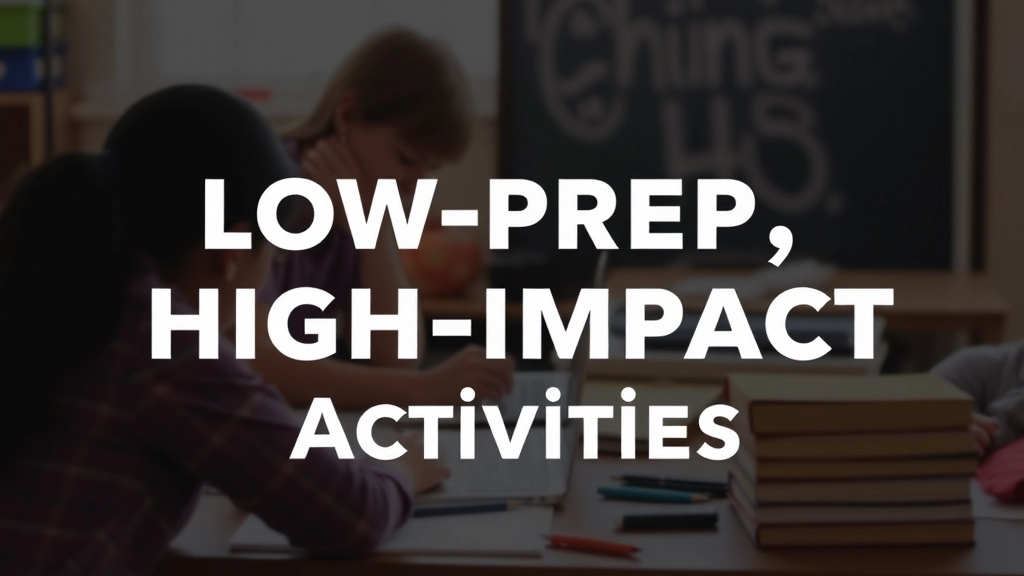
Ever feel like planning camp activities is more stressful than fun? We’ve all been there.
So, let’s talk about low-prep, high-impact activities. These are the golden nuggets that keep kids engaged without you needing to spend hours prepping.
Why Low-Prep, High-Impact?
First off, time is precious.
You don’t want to waste it on complicated setups.
Plus, kids have short attention spans.
They need activities that are quick to start and easy to dive into.
Quick Wins: Activities That Work
Here are some tried-and-true activities that require minimal prep but deliver maximum fun:
- Scavenger Hunts:
- Make a list of items for kids to find around the camp.
- Nature-themed? Even better.
- Split them into teams and go!
- DIY Crafts:
- Think paper plate masks, friendship bracelets, or rock painting.
- Use materials you already have.
- Minute to Win It Games:
- Simple, fast-paced challenges.
- Stack cups, balance pencils, or move cotton balls with a spoon.
- Loads of fun, zero hassle.
- Storytelling Circles:
- Gather around and take turns adding to a story.
- No materials needed, just imagination.
Real Stories, Real Results
Last summer, we tried a scavenger hunt with a nature twist.
Kids had a blast finding leaves, rocks, and twigs.
No prep, just pure fun.
Another hit? Minute to Win It games.
We had kids laughing and cheering in no time.
Tips for Success
- Keep It Simple:
- The simpler, the better.
- Kids don’t need fancy; they need fun.
- Be Flexible:
- Adapt activities based on the group’s energy.
- Have backup plans in case something flops.
- Engage With Them:
- Join in the activities.
- Your enthusiasm is contagious.
Ideas for Nature-Based and Outdoor Camps
Alright, let’s cut to the chase. When it comes to planning nature-based and outdoor camps, you’re probably wondering: How do I keep kids entertained and engaged without the usual gadgets and screens? How can I make sure they actually learn something while having fun? Trust me, you’re not alone in these worries. I’ve been there, and I’ve got some solid ideas to share.
Kick-off with Nature Scavenger Hunts
Keyword: Nature-based camps
A nature scavenger hunt is a classic for a reason. It’s simple, requires minimal prep, and kids love it. Here’s how you can make it work:
- Create a List: Jot down items they need to findâthink leaves, rocks, insects, or even specific types of plants.
- Teams or Solo: Depending on the group size, you can split them into teams or let them go solo.
- Prizes: Small rewards can make a big difference. Maybe a badge or a treat for the winning team.
Storytelling Around a Campfire
Nothing beats the magic of a campfire story. It’s a great way to wind down after a day full of activities.
- Mix It Up: Share a mix of folklore, personal stories, and maybe even let the kids tell their own tales.
- Interactive Elements: Include some interactive parts like sound effects or actions they can mimic.
- Learning Moments: Slip in some educational bits about local wildlife or history.
Nature Crafts
Keyword: Outdoor camps
Kids love to create, and nature offers endless supplies for crafting.
- Leaf Rubbings: Simple yet effective. All you need are leaves and crayons.
- Rock Painting: Another low-prep, high-impact activity. Bring some paints and let them go wild.
- Nature Collages: Collect items from the surroundings and create a piece of art.
Hiking Adventures
A good hike can be both exhilarating and educational. Here’s how to make it work:
- Plan the Route: Choose a trail that’s suitable for the age group.
- Teach Along the Way: Point out interesting plants, animals, and geological features.
- Safety First: Always have a first aid kit and ensure everyone knows the rules.
Outdoor Science Experiments
Keyword: Nature-based camps
Who says science has to be boring? Take it outside and watch the magic happen.
- Volcano Eruptions: Use baking soda and vinegar to create mini-volcanoes.
- Solar Ovens: Teach them how to harness the sun’s power to cook a simple meal.
- Water Filtration: Show them how to filter water using natural materials.
Wildlife Observation
Kids are naturally curious about animals. Turn this curiosity into a learning opportunity.
- Bird Watching: Provide binoculars and a simple guidebook.
- Bug Hunts: Equip them with magnifying glasses and let them explore.
- Animal Tracks: Teach them how to identify different tracks and what they tell us about the animal.
Team-Building Games
Keyword: Outdoor camps
Outdoor camps are perfect for team-building activities that teach kids cooperation and leadership.
- Trust Falls: A classic that teaches trust and communication.
- Obstacle Courses: Set up a course that requires teamwork to complete.
- Survival Challenges: Pose scenarios where they need to work together to “survive.”
Wrap-Up: Assessing Camper Engagement
So, how do you know if your nature-based camp is a hit? Keep an eye on these signs:
Assessing Camper Engagement
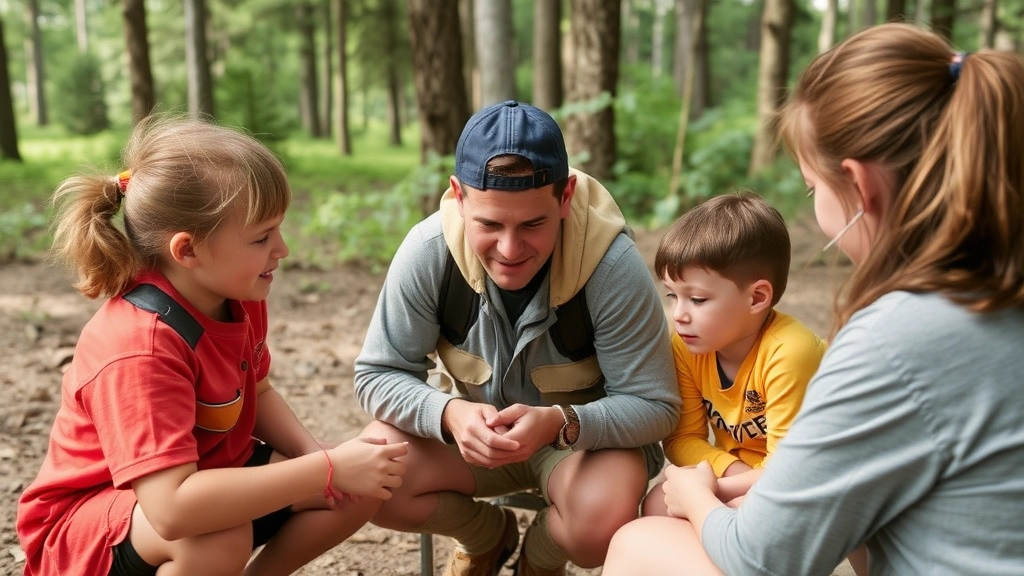
Ever wondered if the kids are really getting into the activities you’ve planned?
Assessing camper engagement can feel like a mystery sometimes.
But it doesn’t have to be.
Here’s how you can crack the code and make sure everyone’s having a blast.
Why Camper Engagement Matters
First off, why should you care about camper engagement?
Simple.
Engaged campers are happy campers.
They learn more, have more fun, and are less likely to cause disruptions.
So, how do we measure it?
Quick Checks for Engagement
You don’t need a PhD to figure out if kids are engaged.
Here are some quick ways:
- Observation: Watch their body language. Are they smiling, laughing, or actively participating?
- Feedback: Ask them directly. Simple questions like, “Did you enjoy that?” or “What was your favourite part?”
- Participation Levels: Count how many kids are actually taking part in the activity. If half are sitting out, you’ve got a problem.
Tools to Measure Engagement
You can also use some nifty tools to get a better handle on things:
- Surveys: Short, simple surveys can give you a lot of insight. Keep them anonymous for honest answers.
- Engagement Apps: There are apps designed to measure engagement. They can track participation and even give you instant feedback.
Real-Life Examples
Let’s get real for a second.
Imagine running a treasure hunt. You notice some kids are more interested in picking flowers than finding clues.
That’s a sign.
Time to switch things up.
Maybe add more interactive clues or pair them with a buddy who’s super into it.
Adjusting On the Fly
Sometimes, you need to pivot quickly.
If an activity isn’t hitting the mark, don’t be afraid to change it up.
- Shorten the Activity: If they’re losing interest, wrap it up early.
- Add a Twist: Introduce a new rule or challenge to reignite interest.
- Switch Activities: Have a backup plan ready. Always.
Keeping it Fresh
Engagement isn’t a one-time thing.
You’ve got to keep it fresh.
- Rotate Activities: Don’t do the same thing every day. Variety keeps things exciting.
- Involve the Campers: Let them choose activities sometimes. When they have a say, they’re more likely to be engaged.
Practical Tips for Managing Large Groups
Managing large groups at a summer camp can be a real challenge, right? You’re juggling a bunch of kids, trying to keep everyone engaged and safe, and let’s face it, sometimes it feels like herding cats. But don’t worry, I’ve got some practical tips to make it easier for you.
Understanding the Challenges
First off, let’s talk about the common worries:
- How do I keep everyone engaged?
- What if some kids feel left out?
- How do I ensure safety without being a buzzkill?
These are all valid concerns, and trust me, we’ve all been there. So let’s dive into some strategies that can help.
1. Break Them Into Smaller Groups
Big groups can be overwhelming. Break them down into smaller, manageable groups. Here’s how:
- Divide by age or interest: This ensures activities are age-appropriate and engaging.
- Assign group leaders: Older kids or camp counsellors can take charge, giving you more eyes and hands to manage the crowd.
2. Clear Communication is Key
When dealing with large groups, communication can make or break your day.
- Use a whistle or bell: Simple, effective, and gets everyone’s attention quickly.
- Set clear expectations: Let them know the plan for the day and the rules upfront. Kids thrive on structure.
3. Rotate Activities
Keep things fresh by rotating activities. This not only keeps kids engaged but also prevents boredom.
- Activity stations: Set up different stations and rotate groups every 20-30 minutes.
- Incorporate variety: Mix physical activities with quiet ones to cater to different energy levels.
4. Engage with Interactive Activities
Interactive activities are a hit with large groups.
- Team-building games: These are great for fostering camaraderie and keeping everyone involved.
- Creative arts and crafts: Easy to set up and can be tailored to different age groups.
5. Safety First
Safety is non-negotiable, but it doesn’t have to be a drag.
- Buddy system: Pair kids up so they always have someone to look out for them.
- Regular headcounts: Do these at every transition point to ensure no one is missing.
- First aid kits: Always have these on hand and ensure staff are trained in basic first aid.
6. Use Technology Wisely
Tech can be your friend when managing large groups.
- Group messaging apps: Keep in touch with your team and share updates quickly.
- Portable PA systems: Great for making announcements without shouting.
Real-Life Example
Let me share a quick story. Last summer, we had a group of 50 kids at our camp. Initially, chaos reigned. But once we broke them into smaller groups and set up rotation stations, things smoothed out. Kids were more engaged, and we could focus on ensuring everyone was having fun and staying safe.
For more tips on organizing your camp, check out our classic activities guide and our budget-friendly tips to make the most of your camp experience.
Tools and Resources for Efficient Camp Planning
Ever find yourself drowning in summer camp prep?
Yeah, me too.
Planning a camp can be a beast, but with the right tools, you can tame it.
Let’s dive into some game-changing resources that make camp planning a breeze.
Digital Tools to Streamline Planning
Camp Management Software
First up, camp management software.
These bad boys handle everything from registrations to medical forms.
- UltraCamp: Handles camper data, payments, and even meal planning.
- CampMinder: Streamlines communication with parents and staff.
- Active Network: Great for large camps with multiple sessions.
Scheduling Apps
Keeping track of activities can be a nightmare.
Scheduling apps can save your sanity.
- Google Calendar: Syncs with everyone’s devices.
- Doodle: Perfect for organising staff meetings.
- Trello: Ideal for visualising tasks and timelines.
Must-Have Physical Resources
Organisational Binders
Old-school binders still have a place.
- One for camper info
- One for staff schedules
- One for daily activity plans
Label Makers
A label maker is your best friend.
Label everything.
Trust me, it’ll save you a ton of headaches.
Online Resources for Inspiration
Pinterest Boards
Looking for fresh activity ideas?
Pinterest is a goldmine.
- Search for themed crafts
- Outdoor games
- STEM projects
Educational Websites
Educational websites can provide structured lesson plans.
- Teachers Pay Teachers: Ready-made activities.
- Khan Academy: Great for STEM ideas.
Real Talk: Stories from the Trenches
I once ran a camp with zero digital tools.
Big mistake.
We lost a kid’s medical form, and chaos ensued.
Since switching to CampMinder, no more lost forms.
Lesson learned.
FAQs
What’s the best software for small camps?
UltraCamp is versatile and scales well, even for small setups.
Do I really need a label maker?
Yes.
It keeps everything organised and reduces stress.
Can I plan a camp without digital tools?
You can, but why would you?
Digital tools save time and reduce errors.
For more tips on efficient camp planning, check out our Mastering Summer Camp Leadership guide. And if you’re looking for ways to keep kids engaged, our Ultimate Guide to Summer Sports Camps is a must-read!
FAQs: Summer Camp Lesson Plan Template
What is a summer camp lesson plan template?
A summer camp lesson plan template is a structured guide that helps camp organizers plan and execute various activities. It ensures that each day is filled with engaging, educational, and fun activities for the campers.
Why are themed activities important in a summer camp?
Themed activities provide structure and excitement to the camp. They make planning easier and keep kids engaged by turning ordinary days into unforgettable adventures.
How do I choose a theme for camp activities?
Pick a theme that is broad enough to include multiple activities but specific enough to be exciting. Popular themes include space exploration, jungle safari, medieval times, superheroes, and underwater adventure.
What are some examples of themed activities?
For a Space Theme, you could have rocket-building crafts, space trivia games, and stories about astronauts. For a Superhero Week, kids could create superhero masks, participate in obstacle courses, and write short stories about their characters.
How can I incorporate STEM and Creative Arts into camp activities?
Incorporate hands-on projects, interactive experiments, art integration, tech time, and storytelling. For example, build a water filter using simple materials or create a stop-motion animation using LEGO sets.
What are low-prep, high-impact activities?
These are activities that require minimal preparation but keep kids highly engaged. Examples include scavenger hunts, DIY crafts, “Minute to Win It” games, and storytelling circles.
How can I assess camper engagement during activities?
Observe their body language, ask for feedback, and monitor participation levels. Use tools like surveys and engagement apps to get more detailed insights.
What should I do if an activity isn’t engaging the campers?
Be ready to adjust on the fly. You can shorten the activity, add a new twist, or switch to a backup plan. Always have alternative activities prepared.
How can I keep camp activities fresh and exciting?
Rotate activities regularly and involve campers in choosing some of the activities. This keeps things varied and ensures that campers remain engaged and excited.
What are some tips for successful camp activity planning?
Prep ahead by gathering all necessary materials, keep activities simple, encourage teamwork, and celebrate the kids’ successes. Your enthusiasm and flexibility also play a crucial role in the success of the activities.
References
-
Engaging Campers Through Themed Activities
-
STEM Activities for Summer Camp
-
Low-Prep, High-Impact Camp Activities

